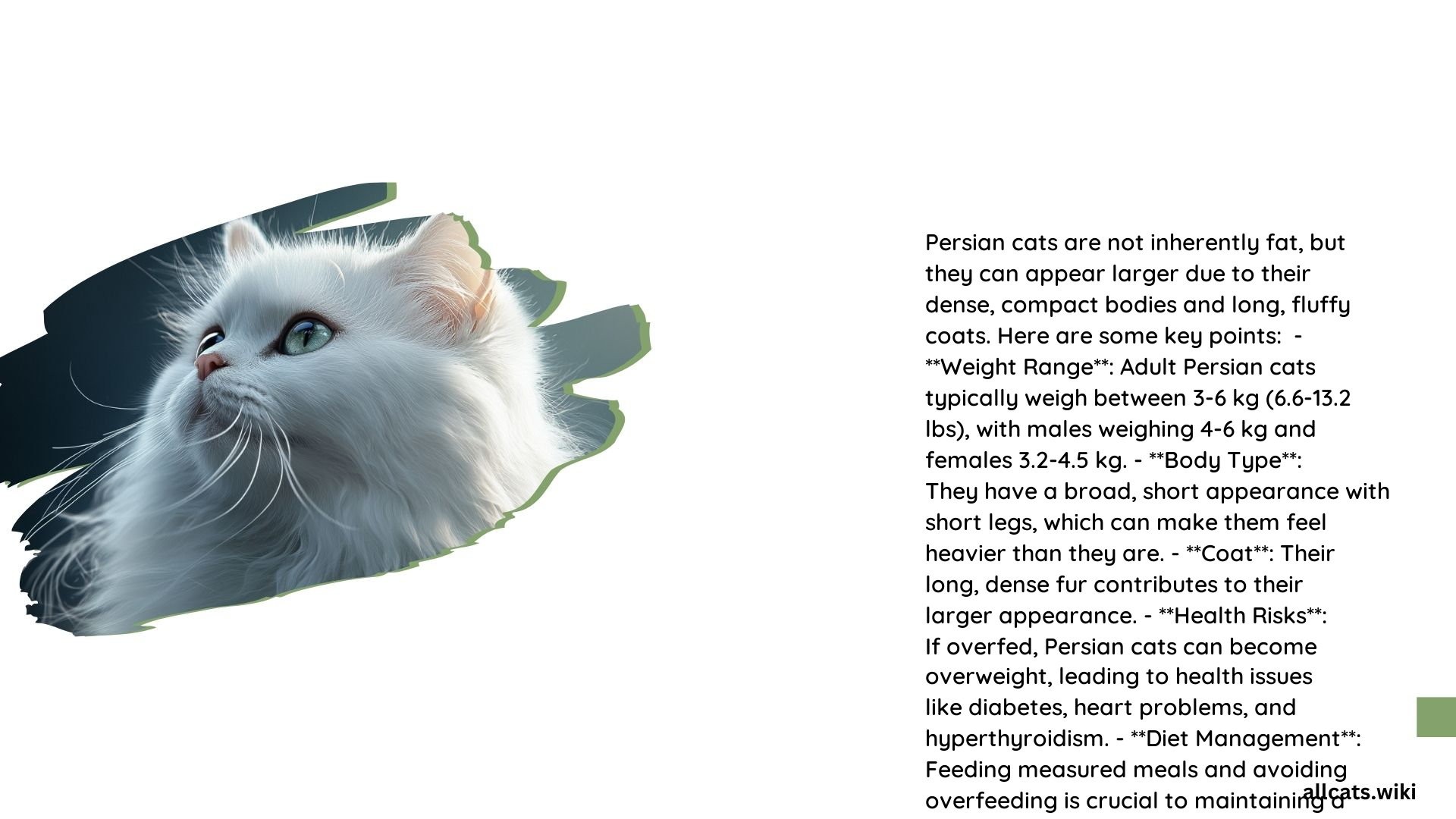Weight Ranges for Persian Cats

Weight Ranges:
– Adult Persian cats typically weigh between 7 to 12 pounds (3.2 to 5.4 kilograms). Male Persian cats usually weigh more than females, with males ranging from 4 to 6 kilograms (8.8 to 13.2 pounds) and females ranging from 3.2 to 4.5 kilograms (7 to 9.9 pounds).
How to Assess Weight and Body Condition in Persian Cats?

What is Body Condition Scoring (BCS)?
- BCS is a reliable method to assess a cat’s weight. Vets use a scale from 1 to 9, where a score of 4-5 is ideal. At this score, you can feel but not see the ribs, and the cat has a noticeable waist when viewed from above.
What Measurements are Important?
- Length and Body Structure: Persian cats have a robust and long body structure with short, thick legs. However, specific length measurements are less relevant for weight assessment compared to body condition scoring.
- Weight Monitoring: Use a consistent scale to weigh your cat at the same time each day. Keeping a growth chart can help track changes in weight over time.
What are the Signs of Obesity in Persian Cats?
- Visible Signs: Obesity in Persian cats can be masked by their long coats, but signs include:
- Visible Fat Pads: Noticeable fat deposits around the base of the tail, along the spine, and on the abdomen.
- Lack of Waist Definition: When viewed from above, the cat’s waist is not visible.
- Reduced Mobility: Overweight cats may show less inclination to move or play.
- Breathing Difficulties: Due to their brachycephalic (flat-faced) skull, overweight Persian cats may experience breathing difficulties.
How to Determine if a Persian Cat is Overweight?
- Visual Inspection:
- Check for a visible waist and palpable ribs. If these are not evident, the cat may be overweight.
- Weight Comparison:
- Compare your cat’s weight to the breed-specific ranges. If your cat exceeds these ranges, it may be overweight.
- Veterinary Consultation:
- Consult with a veterinarian for an accurate assessment. They can perform a physical examination and provide guidance based on your cat’s health history.
What are the Dietary Guidelines and Weight Management Strategies for Persian Cats?
- Balanced Diet:
- Choose high-quality cat food that supports skin and coat health, as well as overall nutrition. Foods should have the right balance of protein, fats, and carbohydrates.
- Portion Control:
- Control food portions to prevent overfeeding. Indoor cats typically require fewer calories than outdoor cats.
- Avoid Overfeeding:
- Resist giving too many treats, as this can lead to weight gain. Limit treats to no more than 10% of the cat’s daily calorie intake.
How Can Exercise Routines Help Persian Cats Maintain a Healthy Weight?
- Encourage Activity:
- Engage your Persian cat in playtime activities to encourage physical activity. Despite their laid-back nature, regular play can help maintain a healthy weight.
What Health Risks are Associated with Obesity in Persian Cats?
- Common Health Issues:
- Obesity in Persian cats can lead to various health problems, including:
- Diabetes: Increased risk due to insulin resistance.
- Joint Issues: Excess weight can strain joints, leading to arthritis.
- Respiratory Problems: Breathing difficulties can worsen due to their brachycephalic skull.
- Gastrointestinal Issues: Conditions like IBS and constipation can be exacerbated by obesity.
What Steps Should You Take if You Suspect Your Persian Cat is Overweight?
- Consult a Veterinarian:
- Get a professional assessment to determine if your cat is overweight and to rule out any underlying health issues.
- Adjust Diet and Exercise:
- Implement a weight management plan that includes a balanced diet and increased physical activity.
- Monitor Progress:
- Regularly weigh your cat and track changes in body condition to ensure the weight management plan is effective.
References
- Untamed: How much do Persian cats weigh?
- Conservation Cub Club: Persian Cats
- Cat Tree UK: Understanding Your Cat’s Ideal Weight
